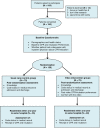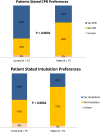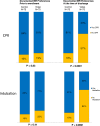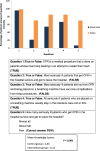A Randomized Controlled Trial of a CPR and Intubation Video Decision Support Tool for Hospitalized Patients
- PMID: 25691237
- PMCID: PMC4510229
- DOI: 10.1007/s11606-015-3200-2
A Randomized Controlled Trial of a CPR and Intubation Video Decision Support Tool for Hospitalized Patients
Abstract
Background: Decisions about cardiopulmonary resuscitation (CPR) and intubation are a core part of advance care planning, particularly for seriously ill hospitalized patients. However, these discussions are often avoided.
Objectives: We aimed to examine the impact of a video decision tool for CPR and intubation on patients' choices, knowledge, medical orders, and discussions with providers.
Design: This was a prospective randomized trial conducted between 9 March 2011 and 1 June 2013 on the internal medicine services at two hospitals in Boston.
Participants: One hundred and fifty seriously ill hospitalized patients over the age of 60 with an advanced illness and a prognosis of 1 year or less were included. Mean age was 76 and 51% were women.
Intervention: Three-minute video describing CPR and intubation plus verbal communication of participants' preferences to their physicians (intervention) (N = 75) or control arm (usual care) (N = 75).
Main measures: The primary outcome was participants' preferences for CPR and intubation (immediately after viewing the video in the intervention arm). Secondary outcomes included: orders to withhold CPR/intubation, documented discussions with providers during hospitalization, and participants' knowledge of CPR/ intubation (five-item test, range 0-5, higher scores indicate greater knowledge).
Results: Intervention participants (vs. controls) were more likely not to want CPR (64% vs. 32%, p <0.0001) and intubation (72% vs. 43%, p < 0.0001). Intervention participants (vs. controls) were also more likely to have orders to withhold CPR (57% vs. 19%, p < 0.0001) and intubation (64% vs.19%, p < 0.0001) by hospital discharge, documented discussions about their preferences (81% vs. 43%, p < 0.0001), and higher mean knowledge scores (4.11 vs. 2.45; p < 0.0001).
Conclusions: Seriously ill patients who viewed a video about CPR and intubation were more likely not to want these treatments, be better informed about their options, have orders to forgo CPR/ intubation, and discuss preferences with providers.
Trial registration: Clinicaltrials.gov NCT01325519 Registry Name: A prospective randomized trial using video images in advance care planning in seriously ill hospitalized patients.
Figures





Comment in
-
Improving End-of-Life Decision-Making About Resuscitation and Intubation.J Gen Intern Med. 2015 Aug;30(8):1049-50. doi: 10.1007/s11606-015-3287-5. J Gen Intern Med. 2015. PMID: 25893420 Free PMC article. No abstract available.
Similar articles
-
Association of Communication Interventions to Discuss Code Status With Patient Decisions for Do-Not-Resuscitate Orders: A Systematic Review and Meta-analysis.JAMA Netw Open. 2019 Jun 5;2(6):e195033. doi: 10.1001/jamanetworkopen.2019.5033. JAMA Netw Open. 2019. PMID: 31173119 Free PMC article.
-
A Randomized Controlled Trial of a CPR Decision Support Video for Patients Admitted to the General Medicine Service.J Hosp Med. 2017 Sep;12(9):700-704. doi: 10.12788/jhm.2791. J Hosp Med. 2017. PMID: 28914272 Clinical Trial.
-
Randomized, Controlled Trial of an Advance Care Planning Video Decision Support Tool for Patients With Advanced Heart Failure.Circulation. 2016 Jul 5;134(1):52-60. doi: 10.1161/CIRCULATIONAHA.116.021937. Circulation. 2016. PMID: 27358437 Free PMC article. Clinical Trial.
-
A controlled trial to improve care for seriously ill hospitalized patients. The study to understand prognoses and preferences for outcomes and risks of treatments (SUPPORT). The SUPPORT Principal Investigators.JAMA. 1995 Nov 22-29;274(20):1591-8. JAMA. 1995. PMID: 7474243 Clinical Trial.
-
The effects of patient race on outcomes in seriously ill patients in SUPPORT: an overview of economic impact, medical intervention, and end-of-life decisions. Study to Understand Prognoses and Preferences for Outcomes and Risks of Treatments.J Am Geriatr Soc. 2000 May;48(S1):S194-8. doi: 10.1111/j.1532-5415.2000.tb03132.x. J Am Geriatr Soc. 2000. PMID: 10809475 Review.
Cited by
-
Association of an Advance Care Planning Video and Communication Intervention With Documentation of Advance Care Planning Among Older Adults: A Nonrandomized Controlled Trial.JAMA Netw Open. 2022 Feb 1;5(2):e220354. doi: 10.1001/jamanetworkopen.2022.0354. JAMA Netw Open. 2022. PMID: 35201306 Free PMC article.
-
Association of Communication Interventions to Discuss Code Status With Patient Decisions for Do-Not-Resuscitate Orders: A Systematic Review and Meta-analysis.JAMA Netw Open. 2019 Jun 5;2(6):e195033. doi: 10.1001/jamanetworkopen.2019.5033. JAMA Netw Open. 2019. PMID: 31173119 Free PMC article.
-
Decision coaching for people making healthcare decisions.Cochrane Database Syst Rev. 2021 Nov 8;11(11):CD013385. doi: 10.1002/14651858.CD013385.pub2. Cochrane Database Syst Rev. 2021. PMID: 34749427 Free PMC article.
-
Improving End-of-Life Decision-Making About Resuscitation and Intubation.J Gen Intern Med. 2015 Aug;30(8):1049-50. doi: 10.1007/s11606-015-3287-5. J Gen Intern Med. 2015. PMID: 25893420 Free PMC article. No abstract available.
-
A dynamic application of PRECIS-2 to evaluate implementation in a pragmatic, cluster randomized clinical trial in two nursing home systems.Trials. 2018 Aug 22;19(1):453. doi: 10.1186/s13063-018-2817-y. Trials. 2018. PMID: 30134976 Free PMC article. Clinical Trial.
References
-
- A controlled trial to improve care for seriously ill hospitalized patients. The study to understand prognoses and preferences for outcomes and risks of treatments (SUPPORT). The SUPPORT Principal Investigators. JAMA. 1995;274(20):1591–8. - PubMed
Publication types
MeSH terms
Associated data
Grants and funding
LinkOut - more resources
Full Text Sources
Other Literature Sources
Medical

